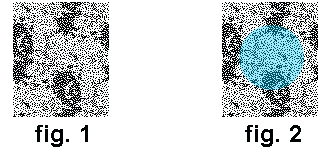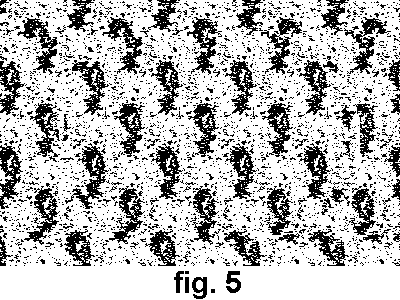
How do they work?
THE FIRST RANDOM
dot stereogram was invented by Dr. Bela Julesz in 1959 as an experiment to test stereopsis, the ability to see in 3D. Read more about the history of stereograms here LINKLINKLINK. By using a random dot pattern, Julesz eliminated the depth cues that are inherent in recognizable images.Consider this example. First create a rectangle of randomly arranged dots. (fig 1). Within that rectangle select a group of dots that make up a small shape. In this example the small shape is a circle and the selected dots are the dots that fall within the blue circle. (fig. 2).

Next, create a new rectangle identical to the original rectangle, except that the dots within the small shape have been shifted to the left. (fig. 3). When the two rectangles are viewed together as a stereo pair, the image of the circle appears to float above the background. (fig. 4).

In 1979 Christopher Tyler discovered that the offset scheme could be applied to a single image. This was the birth of the single image random dot stereogram (fig. 5).

This works because of this:
When I look at an object i get a different image in each eye. Each of these images is slightly different since each of my eyes is at a slightly different angle from the object. When I combine these two images, my mind is able to use these discrepancies to unconsciously create the phenomena of depth perception.
A stereogram, however has no depth to it, since it rests on a plane. So, I need to trick my eyes into giving my brain 2 slightly different images. In order to do this, I draw two different images on the plane (these are the two images that I would have had in each respective eye had the object really been three dimensional). When I just look at the paper, both eyes focus on the same point, but if I look beyond the paper, then the triangle created by my eyes and my focal point is intersected. The points of this intersection are the images that each eye sees. This point should be over each respective image on the stereogram.
So, if I am in focus behind the plane that the stereogram rests on, and my line of sight of each eye rests on each image of the stereogram, then I have each image in each eye. When this occurs, it is just as if I was seeing the real object, and I perceive depth.
Of Course, in order to see a stereogram, a person must have depth perception. Depth perception depends on having two eyes. To understand how a stereogram works, you must understand how the eye works LINKLINKLINK. Most people who have depth perception can see a Magic Eye image. People with impaired depth perception or people who have one eye which is extremely dominant (as in amblyopia) will have more difficulty seeing the image. To see exactly who may be effected, take a look at this LINKLINKLINK.
A stereogram is seen by allowing the eyes to diverge. It's as if you're focused on an object that is more distant than the printed page. However, if you cross your eyes you will invert the image (see the image inside out). Crossing the eyes may also strain the eyes. The normal diverging technique can actually help you learn to relax your eyes.
Back to StereogramLINKLINKLINK